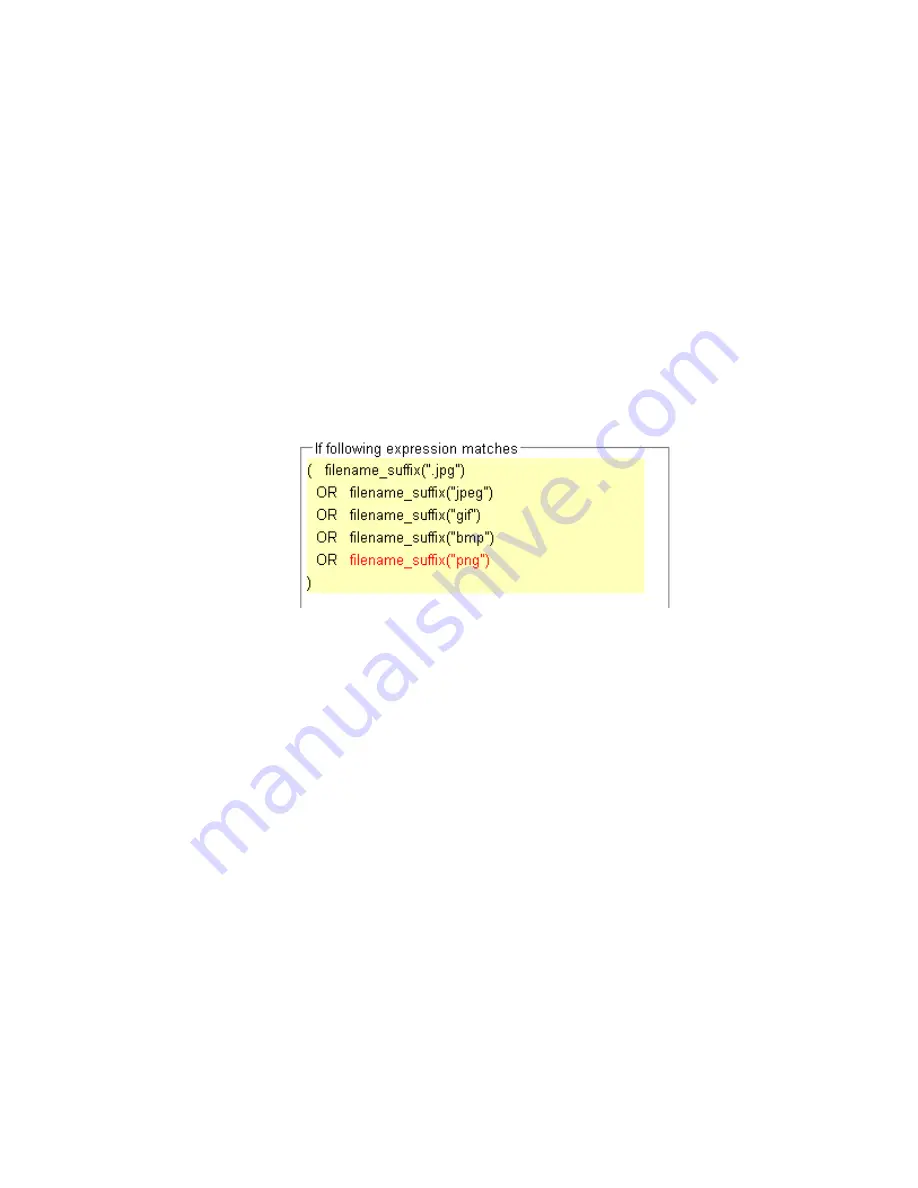
Example Match Rules
Equalizer Installation and Administration Guide
235
4. In the
expression
field, click
any()
to open the
Select function
dialog:
a.
Select
replace with filename_suffix
from the drop-down box.
b. Type “
jpg
” into the
filename suffix
text box.
c.
Select
continue
.
5. In the
expression
field, click
filename suffix(“jpg”)
to open the
Select function
dialog:
a.
Select
replace with filename_suffix OR any()
from the drop-down box.
b. Select
continue
.
6. In the
expression
field, click
any()
to open the
Select function
dialog:
a.
Select
replace with filename_suffix
from the drop-down box.
b. Type “
jpeg
” into the
filename suffix
text box.
c.
Select
continue
.
7. Repeat Steps 5 and 6 for each of the other filename suffixes on our example servers --
gif
,
bmp
, and
png
.
When you are done, the match expression should look like this:
8. Select the
commit
button to save your changes to the
images
rule.
9. The
images
rule we created selects all the requests for image files; now we need a rule to determine which
servers will receive all the other requests. The Default rule is not sufficient, and in fact we don’t want it to be
reached, since it could send a request for content to one of the image servers. So, we’ll create another rule with
the same match expression as the Default [
any
()
], but a restricted list of servers. This effectively
replaces
the
Default match rule with one of our own.
In the left frame, right-click the name of the cluster and select
Add Match Rule
. The
Add Match Rule
screen
appears.:
a.
Type “
content”
into the
match name
text box
b. In the
servers
field, select
sv_102
,
sv_65
, and
sv_120
.
c.
Select
commit
.
The match rule is created, added to the object tree, and its
Configuration
tab is opened:
10. Select
Default
in the
immediately before
drop-down box.
11. Disable the right-hand check box for the
persist
flag; then, enable the left-hand check box next to
persist
.
(Remember that in our example we’re enabling
persist
for the content servers, so that persistent sessions can be
maintained by the applications that run on these servers.)
12. Select the
commit
button to save your changes to the
content
rule.
Summary of Contents for E350GX
Page 18: ...Chapter Preface 18 Equalizer Installation and Administration Guide ...
Page 38: ...Chapter 1 Equalizer Overview 38 Equalizer Installation and Administration Guide ...
Page 80: ...Chapter 4 Equalizer Network Configuration 80 Equalizer Installation and Administration Guide ...
Page 110: ...Chapter 5 Configuring Equalizer Operation 110 Equalizer Installation and Administration Guide ...
Page 208: ...Chapter 7 Monitoring Equalizer Operation 208 Equalizer Installation and Administration Guide ...
Page 240: ...Chapter 8 Using Match Rules 238 Equalizer Installation and Administration Guide ...
Page 262: ...Appendix A Server Agent Probes 258 Equalizer Installation and Administration Guide ...
Page 274: ...Appendix B Timeout Configuration 270 Equalizer Installation and Administration Guide ...
Page 280: ...Appendix D Regular Expression Format 276 Equalizer Installation and Administration Guide ...
Page 310: ...Appendix F Equalizer VLB 306 Equalizer Installation and Administration Guide ...
Page 318: ...Appendix G Troubleshooting 314 Equalizer Installation and Administration Guide ...






























